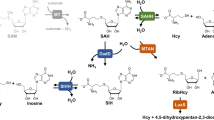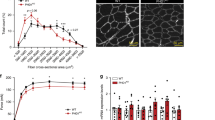Abstract
IT is clear from in vivo1 and in vitro2 studies that vertebrate skeletal muscle contains an enzyme that can condense 1-methylhistidine and β-alanine (in the presence of magnesium and adenosine triphosphate) to yield anserine. However, two other paths of anserine biosynthesis have been suggested1: β-alanyl transfer from carnosine to methylhistidine, and the direct methylation of carnosine. The former possibility has not yet been investigated. The latter alternative is the subject of the present communication. While methyl-labelled methionine was shown to supply effectively the methyl group of anserine3,4 in vivo it was not evident from such experiments whether N-methylation occurred at the histidine or carnosine stage, nor was the physiological site of anserine formation revealed.
This is a preview of subscription content, access via your institution
Access options
Subscribe to this journal
Receive 51 print issues and online access
$199.00 per year
only $3.90 per issue
Buy this article
- Purchase on Springer Link
- Instant access to full article PDF
Prices may be subject to local taxes which are calculated during checkout
Similar content being viewed by others
References
Harms, W. S., and Winnick, T., Biochim. Biophys. Acta, 15, 480 (1954).
Winnick, T., and Winnick, R. E., Biochim. Biophys. Acta, 31, 47 (1959).
Schenck, J. R., Simmonds, S., Cohn, M., Stevens, M. C., and du Vigneaud, V., J. Biol. Chem., 149, 355 (1943).
McManus, I. R., J. Biol. Chem., 225, 325 (1957).
Cantoni, G. L., J. Biol. Chem., 189, 203, 745 (1951).
Stekol, J. A., Anderson, E. I., and Weiss, S., J. Biol. Chem., 233, 425 (1958).
Winnick, T., and Winnick, R. E., Bull. Soc. Chim. Biol., 40, 1727 (1958).
Rowland, F. S., and Wolfgang, R., Nucleonics, 14, 58 (1956).
Winnick, T., and Winnick, R. E., Biochim. Biophys. Acta, 23, 649 (1957).
Author information
Authors and Affiliations
Rights and permissions
About this article
Cite this article
WINNICK, T., WINNICK, R. Pathways and the Physiological Site of Anserine Formation. Nature 183, 1466–1468 (1959). https://doi.org/10.1038/1831466a0
Issue Date:
DOI: https://doi.org/10.1038/1831466a0
This article is cited by
Comments
By submitting a comment you agree to abide by our Terms and Community Guidelines. If you find something abusive or that does not comply with our terms or guidelines please flag it as inappropriate.



